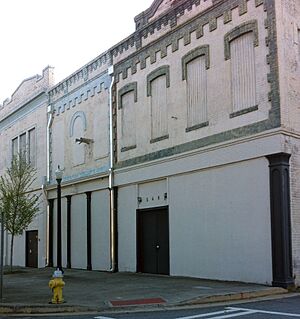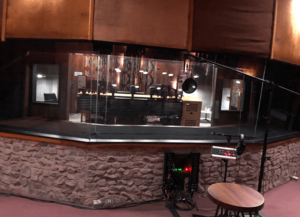Capricorn Records facts for kids
Quick facts for kids Capricorn Records |
|
|---|---|
 |
|
| Parent company | Universal Music Group (first incarnation catalogue) Sony Music Entertainment (second incarnation catalogue) |
| Founded | 1969 |
| Founder | Phil Walden, Frank Fenter |
| Status | Defunct |
| Distributor(s) | First Incarnation Atlantic Records Warner Bros PhonoDisc Second Incarnation RED Distribution PolyGram The Island Def Jam Music Group Reissues Island Records/UMe (first incarnation catalogue) Volcano Entertainment/Legacy Recordings (second incarnation catalogue) |
| Genre | |
| Country of origin | U.S. |
| Location | Macon, Georgia |
Capricorn Records was a special music company started by Phil Walden and Frank Fenter in 1969. It was located in Macon, Georgia, in the United States. Many people say Capricorn Records helped create a new type of music called southern rock. This music mixed rock, blues, and country sounds.
Contents
History of Capricorn Records
How the Label and Studio Started
In the early 1960s, Phil Walden and his brother Alan managed famous R&B singers like Otis Redding. They dreamed of having their own recording studio. After Otis Redding passed away in 1967, Phil Walden still wanted to make this dream come true.
Walden and Frank Fenter talked to Jerry Wexler from Atlantic Records. Wexler liked the idea of a studio with its own musicians. He also thought they should start a record label. They named both the studio and the label "Capricorn" because it was their shared astrological sign. With money from Wexler and a deal with Atlantic Records, Capricorn Records opened in 1969.
The First Era: The 1970s
Before it was Capricorn, the studio was called the Otis Redding Memorial Studio. From the outside, it looked like an old, empty building. But inside, it was a large, open space like a warehouse.
The main recording studio was designed by Jim Hawkins. Later, in 1972, Tom Hidley redesigned it. The new design used special walls to make the sound just right. There were also four echo chambers under the studio. These rooms helped create cool echo effects for voices and instruments.
Musicians loved recording there. They called the studio "home" because it felt so welcoming. Elvin Bishop said Capricorn Records was unique in the South at that time.
Phil Walden wanted the studio to be like other famous studios, offering a cozy place to record. Capricorn Records had its own group of musicians called the Capricorn Rhythm Section (CRS). They played on many songs. The band included drummer Johnny Sandlin, keyboard player Paul Hornsby, guitarist Pete Carr, and bassist Robert “Pops” Powell.
Walden found a talented guitarist named Duane Allman. Allman helped Walden form The Allman Brothers Band. Their first album in 1969 was not a huge hit. But their third album, At Fillmore East, became very popular. It helped make southern rock a well-known music style. This album was the first "gold album" for both the band and Capricorn Records. They had more hit albums like Eat a Peach and Brothers and Sisters.
Between 1969 and 1979, Capricorn Records produced many successful albums. They had nine "platinum albums" (meaning they sold over a million copies) and seventeen "gold albums" (selling over 500,000 copies). Many other artists also recorded at Capricorn. These included the Charlie Daniels Band and Martin Mull.
Other artists who recorded for Capricorn during this time were:
- Bonnie Bramlett
- The Cooper Brothers
- Cowboy
- Delbert McClinton
- Dixie Dregs
- The Marshall Tucker Band
- Percy Sledge
- Sea Level
- Wet Willie
The End of an Era
In the mid-1970s, Capricorn Records faced some challenges. The Allman Brothers Band, their most famous group, broke up in 1976. Also, the economy was not doing well, which affected music sales.
By 1979, Capricorn Records had money problems. They had to close their office in Los Angeles and cut jobs in Macon. The company that distributed their music, PolyGram, asked for their money back. Many artists left Capricorn Records.
The company went through a long process to reorganize its business. Phil Walden was able to keep the Capricorn name and the studio. But PolyGram received all the old recordings and music rights. Later, in 1983, Phil Walden and Frank Fenter tried to restart Capricorn Records. But Frank Fenter sadly passed away. In 1986, many items from Capricorn Records were sold.
The Second Era: The 1990s
Capricorn Records started again in the 1990s in Nashville, Tennessee. This time, Phil Walden worked with his son. The first band to sign with the new Capricorn was Widespread Panic in 1991.
Some of the most successful bands from this time were Cake and 311. Cake's album Prolonging the Magic sold over a million copies. Kenny Chesney, who later became a huge country star, also signed with Capricorn. Other rock bands like Gov't Mule were part of the label too.
In 2000, Phil Walden sold Capricorn Records for $13 million. He then started a new music company called Velocette Records.
Studio Renovation and Reopening
For many years, the Capricorn Sound Studios sat empty. In 2010, it was listed as one of Georgia's "Places in Peril" because it was in danger of being lost. The studio had survived a fire that destroyed nearby buildings.
In 2015, a big project began to fix up the studio. Mercer University and other groups worked together. They planned to restore the original studio. They also wanted to add a museum and apartments.
On December 3, 2019, the studio reopened as Mercer Music at Capricorn. This was 50 years after the original studio opened! Money for the project came from foundations and donations.
Now, the renovated building has apartments, a small bar, a museum, and spaces for musicians. Studio B is a large studio for choirs and orchestras. Studio A is the original historic studio. It looks almost the same as it did in 1972. The museum shows the history of Capricorn Records with artifacts and interactive displays. Visitors can listen to music and learn about the artists.
Capricorn's Impact
Music and Community
In the 1970s, Capricorn Records made Macon, Georgia, a famous music city. Many small music venues and large concert halls were filled with famous bands. Capricorn also invested in local properties in Macon.
Phil Walden, the founder, was also involved in politics. He supported Jimmy Carter when Carter ran for president in 1976. Capricorn bands like the Allman Brothers Band played at Carter's events. Carter even used a song by the Charlie Daniels Band as his campaign song.
Walden also hosted fun annual parties called the Barbecue and Summer Games. These parties attracted many famous people like Andy Warhol and President Jimmy Carter.
Capricorn Records also gained international attention. A British TV show called Old Grey Whistle Test had a special episode about Macon. It showed performances by Capricorn artists like the Marshall Tucker Band.
See also
- Albums released on Capricorn Records
- List of record labels
- Paragon Booking Agency




